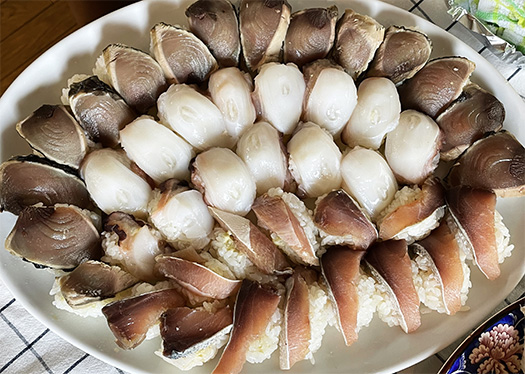


きのうは身内の誕生日祝いにお昼に手握り寿司パーティ。
前日夜までにネタを捌いて、容器に入れて水分を「飛ばして」おいて、朝6時前頃には握りを開始。ことし2度目の握りでしたが、わたしはやはり寿司職人があこがれの仕事のようで(笑)さっそく三昧気分没入。
捌いておいたネタのひとつひとつと一期一会で再会して(って、論理矛盾ですがご容赦)その姿カタチを再確認しながら、シャリと合体させて微妙な仕上がり具合を手探りしていく。切り身のひとつひとつにはどうしても不揃いが発生することは避けられない。それをシャリとうまく整合させていくのが醍醐味。
1コ1コの寿司の側ではシャリとネタがこの世ではじめてめぐり会って、職人であるわたしの手許にすべてを委ねて瞬間の出会いで一体化していく。まるで人間社会の夫婦関係ともつながるのだろうか。美男美女同士のうらやましい合体もあるし、一方、割れナベに閉じブタ的なユニークな合体もある。むしろ、そっちの方が「運命の造作者」としては工夫のオモシロさを感じさせてくれる。ひとも羨む美男美女カップルが必ずしもシアワセであるかどうかは、やっぱりわからないのだろう。
そうした寿司たちを平皿に盛り付けていく。1コ1コのそれらが語り合いながら、ふさわしい距離感で整列し、全体としてのネタの同一性での整列感に従ってやわらかく並んでいく。それぞれ、個性がしっかり表現されながら、均質感も醸成されていく。
そして別のネタに移行していくとき、ネタ同士の色合い、肌つやの違いに配慮しながら「対話」させるように念じながらならべていく。わたしとしては、手許のシャリとネタ、そして練り込むわさびの合体・握り作業のリズム感に全身をゆだね、ただ淡々とその時間との一期一会感に無心で包まれていく。


世界でもいちばん漁業のさかんなこの列島社会で基層的だった魚食文化が、コメ文化と出会ってこういう表現手段にまで至ったのには、この列島で生きてきた無数のひとびとの思いと知恵が込められているのだろうと思える。コメに微妙な酢味をつけて、魚のうまみを極限化させる味覚文化。
握る合間には、わすれていたイカを思い出して(笑)急遽イカとコンニャク・油揚げに、お米の炊飯時に下味付けとして載せたコンブをもあえた煮付けを作っていた。こっちには、山の幸、乾燥シイタケの戻し出汁をベースに利用。箸休めに前日作っておいたカブ大根の一夜漬けとのコンビネーション。
そして出来上がって、みんなで和気あいあいと楽しむのだけれど、一方ではいろいろな反省点なども自分の内側から目覚めてくる。
「そうか、ここのところはもっとこうした方がいいなぁ」などと、次回のリベンジを誓っていたりする。なかなかの「職人魂」のめげなさ、ヘタのヨコ好き?であります(笑)。
English version⬇
The last of the consecutive holidays is “hand-rolled” sushi 142 pieces full of rice.
I’m crazy about it. The subtle vinegar flavor is added to the rice to maximize the flavor of the fish. This is a food culture unique to this archipelago, even in the global environment. The “heta no yoko” (love of fish) explodes (laughter). Laughs.
Yesterday, we had a hand-rolled sushi party at noon to celebrate my relatives’ birthday.
I had processed the ingredients the night before, put them in a container and “skimmed” off the water, and started nigiri around 6:00 in the morning. It was my second nigiri this year, and it seems that being a sushi chef is a job I have always longed to do.
I met each piece of fish I had already processed once in a lifetime (a logical contradiction, I know, but forgive me), reconfirming its shape and form, and then combining it with the rice, groping for the subtle perfect finish. It is inevitable that there will be irregularities in each fillet. The real pleasure lies in matching them with the rice.
The rice and the fish meet for the first time in this world on the side of each piece of sushi, and they are united in a momentary encounter, entrusting everything to my hands as a craftsman. It is as if it were a marriage relationship in human society. There are enviable mergers between beautiful men and women, but there are also unique mergers that are like a pig in a cracked pot. In fact, those are more interesting to me as a “creator of destiny” because of the ingenuity of the creator. It is hard to say whether a couple of beautiful men and women who are the envy of others is necessarily happy or not.
The sushi are arranged on a flat plate, one by one, talking to each other and arranged at a suitable distance, softly arranged according to the sense of alignment of the ingredients as a whole. Each piece expresses its own individuality while at the same time fostering a sense of homogeneity.
When moving on to the other ingredients, I arrange them in a way that allows them to “talk” to each other, paying attention to the differences in coloring and texture. As for me, I just let my whole body fall into the rhythmic rhythm of the nigiri process of combining and kneading the rice, the neta, and the wasabi, and I was wrapped in a sense of a once-in-a-lifetime encounter with the time at hand without thinking.
The fact that the fish-eating culture, which was fundamental to this archipelagic society with the world’s largest fishing industry, has found its way into this form of expression through the encounter with rice culture is a reflection of the thoughts and wisdom of countless people who have lived in this archipelago. This is a taste culture that puts a subtle vinegar flavor on rice to maximize the umami of the fish.
In between nigiri, I remembered the squid I had forgotten about (laugh) and hurriedly made a stew of squid, konjak, fried tofu, and kombu (kelp) that I had added as seasoning when the rice was cooked. I used the soup stock from dried shiitake mushrooms, a delicacy of the mountains, as a base. For a chopstick rest, he combined it with the pickled turnip radish that he had made the day before.
After the dish was finished, everyone enjoyed it in a friendly atmosphere, but on the other hand, various reflections were awakened from within.
I see, I should have done better in this part,” they say, vowing to take revenge the next time. I am a very persistent “craftsman’s spirit,” and a lover of the heta no yoko. I am a “craftsman” (laugh).
Posted on 2月 26th, 2024 by 三木 奎吾
Filed under: おとこの料理&食







コメントを投稿
「※誹謗中傷や、悪意のある書き込み、営利目的などのコメントを防ぐために、投稿された全てのコメントは一時的に保留されますのでご了承ください。」
You must be logged in to post a comment.